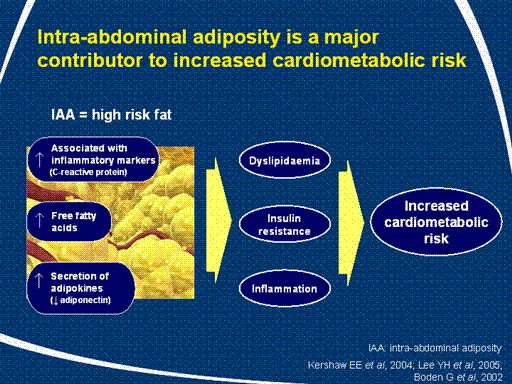| front |1 |2 |3 |4 |5 |6 |7 |8 |9 |10 |11 |12 |13 |14 |15 |16 |17 |18 |19 |20 |21 |22 |23 |24 |25 |26 |27 |28 |29 |30 |31 |32 |33 |34 |35 |36 |review |
 |
This slide summarises the relationships between
intra-abdominal adiposity (IAA) and increased
cardiometabolic risk. Intra-abdominal adiposity drives the
progression of multiple risk factors directly, through the secretion of
excess free fatty acids and inflammatory adipokines, and decreased
secretion of adiponectin. The important contributions of IAA to
dyslipidaemia and insulin resistance provide an indirect, though
clinically important, link to the genesis and progression of
atherosclerosis and cardiovascular disease.
The location of excess IAA is an important determinant of
cardiometabolic risk. IAA is
associated with insulin resistance, hyperglycaemia, dyslipidaemia,
hypertension, and prothrombotic/proinflammatory states. Excess IAA
typically is accompanied by elevated levels of C-reactive protein (CRP)
and free fatty acids (FFAs), as well as decreased levels of adiponectin.
Elevated CRP is an indicator of inflammation. Abdominal obesity has been
shown to be associated with the inflammation cascade, with adipose
tissue expressing a number of inflammatory cytokines. Inflammation is
now believed to play a role in the development of atherosclerosis and
type 2 diabetes. Elevated levels of CRP are considered to be predictive
of cardiovascular disease and insulin resistance.
Elevated FFA levels appear to play a significant role in the
cause of insulin resistance. It has
been suggested that elevated FFAs and intracellular lipids inhibit the
insulin signaling mechanism, leading to decreased glucose transport to
muscle. FFAs also play a mediating role between insulin resistance and
β-cell dysfunction, indicating that a
reduction in FFA level could
be a desirable therapeutic target.
Adiponectin is an adipose tissue-specific circulating protein
which is involved in the regulation of
lipid and glucose metabolism. Adiponectin has been shown to be reduced
in adults with obesity and type 2 diabetes. In non-diabetics,
hypertriglyceridaemia and low HDL-cholesterol have been shown to be
associated with low plasma adiponectin concentrations.
All of these components help to explain why excess abdominal
adiposity is considered to be a
great threat to cardiovascular and metabolic health.
|